
All Solutions
Page 590: Unit Review
The true one is: “A light ray is partially reflected and partially transmitted when it strikes a surface such as piece of glass.”
True statement will be:
The centre of the lens is called the optical centre.
True statement will be:
“A converging lens converge parallel light rays after the reflection.
True statement will be:
“A light ray that is parallel to the principal axis of lens can be refracted.”
True statement would be:
“The function of film in a camera is most like the function of the retina in the human eye”
True statement would be:
“An object located at the secondary principal focus 2F, of a converging lens has an image that is exactly the same size as the object.”
$textit{b.}$, Infrared light – DVD player remote controls
$textit{c.}$, Visible light – human vision
$textit{d.}$, Radio waves – radar
$textit{e.}$, X-rays – dental imaging
$textit{b.}$, DVD player remote controls
$textit{c.}$, human vision
$textit{d.}$, radar
$textit{e.}$, dental imaging
$textit{b.}$, Clear, cold winter sky is transparent.
$textit{c.}$, Frosted glass is translucent material.
$textit{d.}$, Brick is opaque material.
$textit{e.}$, Tree is opaque material.
$textit{f.}$, Hazy, polluted air is translucent.
$textit{g.}$, Glass of water is transparent.
$textit{b.}$, transparent
$textit{c.}$, translucent
$textit{d.}$, opaque
$textit{e.}$, opaque
$textit{f.}$, translucent
$textit{g.}$, transparent
Focus of a diverging lens is the point lying on the principal axis of a diverging lens, from where all the light rays in a parallel beam of light appear to diverge from on refraction.
$textit{b.}$, Clean glass slab is a transparent object.
$textit{c.}$, Frosted glass window is translucent object
$textit{b.}$, clean glass – transparent
$textit{c.}$, frosted glass window – translucent
$textit{b.}$, DAD, will be the word that appears different in the plane mirror.
$textit{b.}$, “DAD”
$textit{b.}$, Bioluminescence produces light by chemical processes which take place in living organisms.
$textit{c.}$, Chemiluminescence produce light by chemical reactions and light is produced as a product of these reactions after which there is no dissipation of heat, therefore, this light is safe to use in areas where there is a high risk of fire etc.
$textit{b.}$, Light is produced by chemical processes inside living organisms.
$textit{c.}$, Light is produced as a product of chemical reactions after which the heat is not dissipated.

Metal, which is heated up, will emit light.
In the process of fluorescence, materials absorbs ultraviolet light and emit white light after.
$textit{b.}$, In the process of tribolumiscence when it comes to rubbing, scratching or crushing crystals, life is being emitted.
In the process of phosphorence light is emitted after the ultraviolet light is absorbed.
In the process of fluorescence light is emitted by materials which are absorbing UV light.
$textit{b.}$, In the process of triboluminescence, light is emitted when crystals are rubbed, scratched or crushed.
In the process of phosphorescence light is emitted after the UV light is absorbed.
$textit{b.}$, A crumpled sheet of aluminium foil is exhibiting diffuse reflection since it is the rough surface and there will be dispersion or light rays.
$textit{c.}$, A dense carpet will exhibit diffuse reflection since it has a dull appearance.
$textit{d.}$, A flat sheet of aluminium foil, shiny side up, will exhibit specular reflection since the surface is “smooth”, therefore, there will be regular reflection.
$textit{b.}$, diffuse reflection
$textit{c.}$, diffuse reflection
$textit{d}$, specular reflection
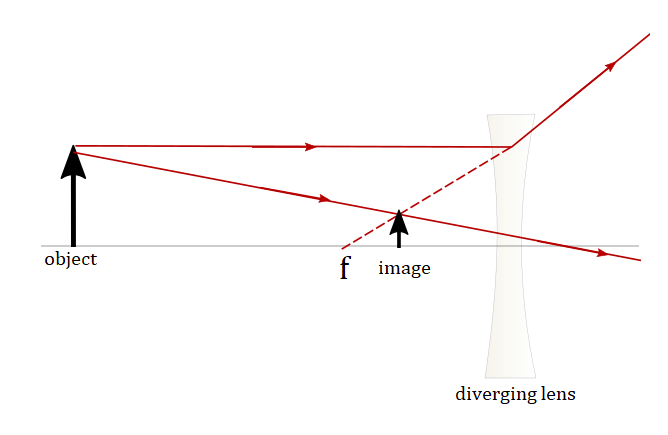
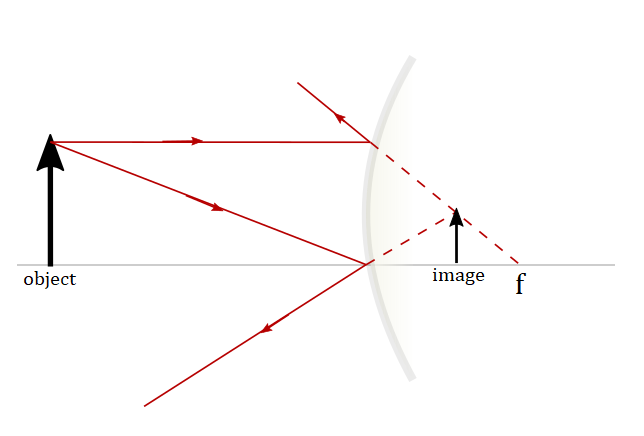
38text{textdegree}
$$
38text{textdegree}
$$
12text{textdegree}
$$
12text{textdegree}
$$
90text{textdegree}-43text{textdegree}=47text{textdegree}
$$
47text{textdegree}
$$
23text{textdegree}
$$
23text{textdegree}
$$
0text{textdegree}
$$
0text{textdegree}
$$
$textit{(a)}$
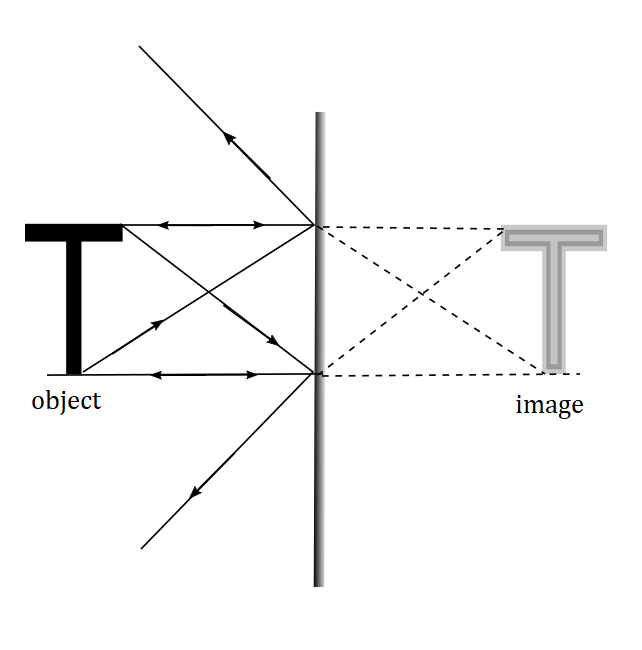
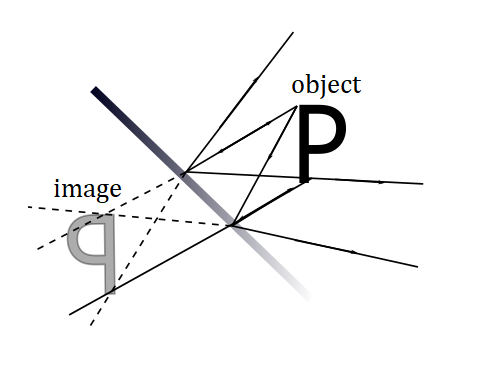
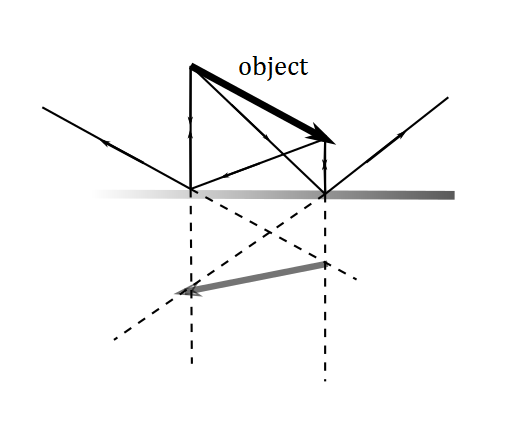
Plane mirror always forms virtual, upright, same shape and size as the object, image where left and right sides are inverted.
$textit{(a)}$
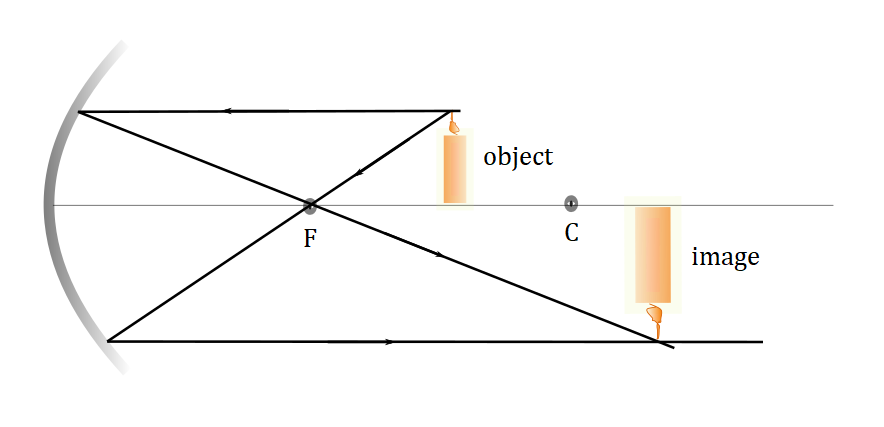
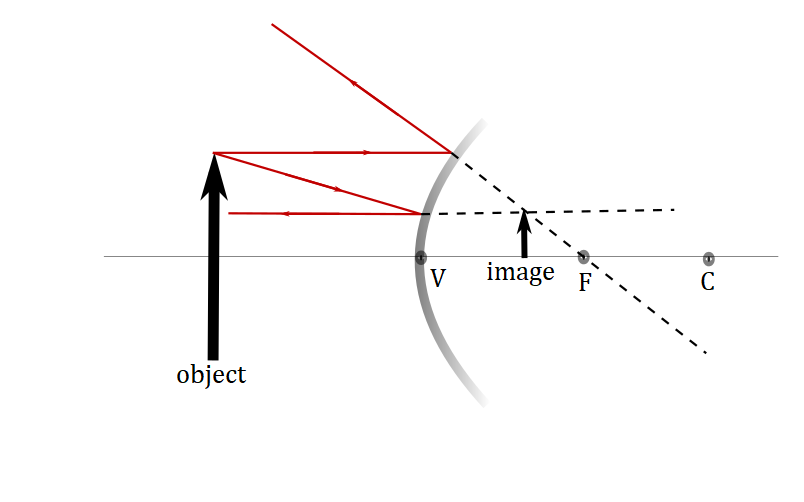
$textit{(a)}$, Image is formed by concave mirror and since the object is placed between focal point and centre, it will be real, enlarged and upside-down image.
a. Material B has a greater index of refraction.
b. Light will travel slower in material B.
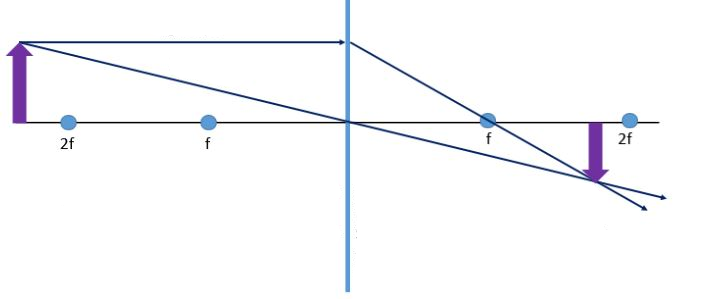
The ultraviolet radiations of the electromagnetic spectrum are the primary cause of skin cancer in the world.
Using generous quantities of sunblock creams and lotions can help create a barrier between the exposed skin and electromagnetic spectrum, protecting the skin from the possible adverse effects of electromagnetic radiations.
$$
d_o=41
$$
$$
f=27
$$
$$
dfrac{1}{d_0}+dfrac{1}{d_i}=dfrac{1}{f}
$$
Rearrange to solve for $d_i$:
$$
dfrac{1}{d_i}=dfrac{1}{f}-dfrac{1}{d_0}
$$
Simplify using least common denominator:
$$
dfrac{1}{d_i}=dfrac{d_0-f}{fd_0}
$$
Rearrange:
$$
d_i=dfrac{fd_0}{d_0-f}
$$
Substitute values:
$$
d_i=dfrac{27(41)}{41-27}=dfrac{1107}{14}
$$
Evaluate:
$$
d_i=79.071
$$
The image formed is $79.071$ centimeters away from the mirror.
$$
d_o=20
$$
$$
f=27
$$
$$
dfrac{1}{d_0}+dfrac{1}{d_i}=dfrac{1}{f}
$$
Rearrange to solve for $d_i$:
$$
dfrac{1}{d_i}=dfrac{1}{f}-dfrac{1}{d_0}
$$
Simplify using least common denominator:
$$
dfrac{1}{d_i}=dfrac{d_0-f}{fd_0}
$$
Rearrange:
$$
d_i=dfrac{fd_0}{d_0-f}
$$
Substitute values:
$$
d_i=dfrac{27(20)}{20-27}=dfrac{540}{-7}
$$
Evaluate:
$$
d_i=-77.143
$$
The image formed is $77.143$ centimeters away from the mirror. The negative sign implies that it is virtual in nature.
$$
c=3times10^8
$$
$$
n=1.46
$$
$$
n=dfrac{c}{v}
$$
Rearrange to solve for $v$:
$$
v=dfrac{c}{n}
$$
Substitute values:
$$
v=dfrac{3times10^8}{1.46}
$$
Simplify and evaluate:
$$
v=2.055times10^8
$$
$$
c=3times10^8
$$
$$
v=2.04times10^8
$$
$$
n=dfrac{c}{v}
$$
Substitute values:
$$
n=dfrac{3times10^8}{2.04times10^8}
$$
Simplify and evaluate:
$$
n=dfrac{3}{2.04}=1.4706
$$
$$
theta_i=45text{textdegree}
$$
$$
theta_r=30text{textdegree}
$$
$$
n=dfrac{sin theta_i}{sin theta_r}
$$
Substitute values:
$$
n=dfrac{sin 45text{textdegree}}{sin 30text{textdegree}}
$$
Evaluate:
$$
n=1.414
$$
This implies that the speed of light in the medium is $dfrac{3times10^8}{1.414}=2.121times10^8$ meters per second.
$$
d_o=23
$$
$$
f=-30
$$
This is a diverging lens and therefore it has a virtual focus and hence the negative value of f.
$$
dfrac{1}{d_0}+dfrac{1}{d_i}=dfrac{1}{f}
$$
Rearrange to solve for $d_i$:
$$
dfrac{1}{d_i}=dfrac{1}{f}-dfrac{1}{d_0}
$$
Simplify using least common denominator:
$$
dfrac{1}{d_i}=dfrac{d_0-f}{fd_0}
$$
Rearrange:
$$
d_i=dfrac{fd_0}{d_0-f}
$$
Substitute values:
$$
d_i=dfrac{-30(23)}{23-(-30)}=dfrac{-690}{53}
$$
Evaluate:
$$
d_i=-13.02
$$
The image formed is $13.02$ centimeters and virtual in nature indicated by the negative sign of $d_i$.
$$
d_o=45
$$
$$
f=34
$$
$$
dfrac{1}{d_0}+dfrac{1}{d_i}=dfrac{1}{f}
$$
Rearrange to solve for $d_i$:
$$
dfrac{1}{d_i}=dfrac{1}{f}-dfrac{1}{d_0}
$$
Simplify using least common denominator:
$$
dfrac{1}{d_i}=dfrac{d_0-f}{fd_0}
$$
Rearrange:
$$
d_i=dfrac{fd_0}{d_0-f}
$$
Substitute values:
$$
d_i=dfrac{34(45)}{45-34}=dfrac{1530}{11}
$$
Evaluate:
$$
d_i=139.09
$$
The image formed is $139.09$ centimeters from the lens and is real in nature and inverted in attitude.
$$
d_o=34
$$
$$
d_i=21
$$
$$
dfrac{1}{f}=dfrac{1}{d_0}+dfrac{1}{d_i}
$$
Substitute values:
$$
dfrac{1}{f}=dfrac{1}{34}+dfrac{1}{21}
$$
Simplify using least common denominator:
$$
dfrac{1}{f}=dfrac{21+34}{34(21)}=dfrac{55}{714}
$$
Solve for $f$:
$$
f=dfrac{714}{55}
$$
Evaluate:
$$
f=12.982
$$
The focal length of the lens is 12.982 centimeters.
$$
d_o=17
$$
$$
f=24
$$
Lens equation:
$$
dfrac{1}{d_0}+dfrac{1}{d_i}=dfrac{1}{f}
$$
Rearrange to solve for $d_i$:
$$
dfrac{1}{d_i}=dfrac{1}{f}-dfrac{1}{d_0}
$$
Simplify using least common denominator:
$$
dfrac{1}{d_i}=dfrac{d_0-f}{fd_0}
$$
Rearrange:
$$
d_i=dfrac{fd_0}{d_0-f}
$$
Substitute values:
$$
d_i=dfrac{24(17)}{17-24}=dfrac{408}{-7}
$$
Evaluate:
$$
d_i=-58.286
$$
The image formed is $58.286$ centimeters from the lens on the same side of the lens as the object. It is virtual in nature and upright in attitude.
Equation of magnification in terms of distance:
$$
M=dfrac{d_i}{d_o}
$$
Substitute values:
$$
M=dfrac{58.286}{17}
$$
Evaluate:
$$
M=3.429
$$
The magnification of the lens is $3.429$
b. $M=3.429$
Data:
$$
d_o=13
$$
$$
d_i=-5
$$
The image is on the same side of the lens as the object, implies that this is a virtual image and hence the negative sign for $d_i$.
$$
dfrac{1}{f}=dfrac{1}{d_0}+dfrac{1}{d_i}
$$
Substitute values:
$$
dfrac{1}{f}=dfrac{1}{13}+dfrac{1}{-5}
$$
Simplify using least common denominator:
$$
dfrac{1}{f}=dfrac{-5+13}{13(-5)}=dfrac{8}{-65}
$$
Solve for $f$:
$$
f=-dfrac{65}{8}
$$
Evaluate:
$$
f=-8.125
$$
The focal length of the lens is $8.125$ centimeters. The negative sign of $f$ implies that the focus is itself virtual in nature; a characteristic property of diverging lenses.
$$
d_i=-12
$$
$$
f=-27
$$
This is a diverging lens and therefore it has a virtual focus and hence the negative value of f.
$$
dfrac{1}{d_o}+dfrac{1}{d_i}=dfrac{1}{f}
$$
Rearrange to solve for $d_o$:
$$
dfrac{1}{d_o}=dfrac{1}{f}-dfrac{1}{d_i}
$$
Simplify using least common denominator:
$$
dfrac{1}{d_o}=dfrac{d_i-f}{fd_i}
$$
Rearrange:
$$
d_o=dfrac{fd_i}{d_i-f}
$$
Substitute values:
$$
d_o=dfrac{-27(-12)}{-12-(-27)}=dfrac{324}{15}
$$
Evaluate:
$$
d_o=21.6
$$
The fruit bowl is $21.6$ centimeters away from the lens.
$$
h_o=19
$$
$$
h_i=58
$$
$$
M=dfrac{h_i}{h_o}
$$
Substitute values:
$$
M=dfrac{58}{19}
$$
Evaluate:
$$
M=3.053
$$
The magnification of the lens is $3.053$
They produce almost no heat and not consume much electrical energy, but what they need is a proper recycling since they contain mercury which has to be disposed properly because of its toxic properties.
LED lights are becoming popular as well since they consume low energy and have a long life.
As a result, they give wide field of view which makes them good for installing on sharp turns on roads which visually inform drivers on the turn about incoming vehicles.
Plants use sunlight to produce their own food by photosynthesis, which as a result gives us oxygen which is important for living, also plants are becoming food for many species.
If there was not heat of the sun, temperatures will be extremely low and there will be almost impossible for life to develop .
There is nothing better than spending your free time at the pool, bath in the sunlight, enjoying its warmth, or is it?
Behind that delightful sunbath, enemy is hiding and this enemy are ultraviolet rays which are very harmful while in a long contact with our skin. They can tear our cells which can cause several mutations which can later lead to cancer. Protect yourself from the enemy! Don’t spend too much time tanning, use sunscreen creams and lotions which can provide a protective barrier between the skin and harmful radiations!
$textit{b.}$, People should not spend too much time tanning because of the harmful ultraviolet rays which can cause mutations and therefore cancer. In order to protect themselves people should use sunscreen creams and lotions which can cause permanent barrier between skin and harmful radiation.
Sun IS the source of life on this planet earth. The heat from the sun keeps the planet warm enough to sustain life. Its light is essential for photosynthesis in plants. Plants manufacture their own food using the process of photosynthesis. This sustains plant life on earth. These plant also become the source of food for all other living organisms on earth and therefore in a sense, it can be said that the sun is the source of life on planet earth without its warmth and light, life on planet earth will cease to exist.
Ultraviolet rays from the sun can be harmful to the human skin and can even lead to skin cancer. Exposure to this can be reduced by staying out of the sun (indoors) during its peak hours and using sunscreen creams and lotions to provide a protective barrier between the skin and these radiations.
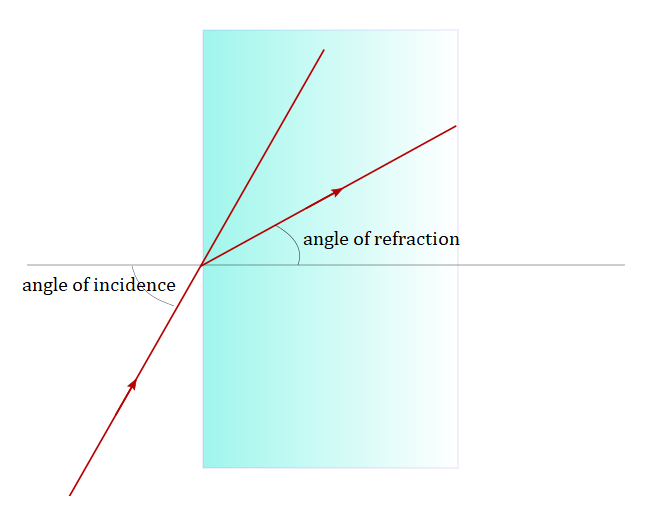
Ray which forms angle of incidence with the principal axis is the incident ray which is entering a new medium and being refracted at the angle of refraction.
hline
& human eye & camera \ hline
light inlet & lens in the eye & camera lens \ hline
which amount will enter the eye/camera & begin{tabular}[c]{@{}l@{}}controlled by dilation\ and reduction of the irisend{tabular} & begin{tabular}[c]{@{}l@{}}controlled by the aperture \ settingsend{tabular} \ hline
type of the image which is formed & real image & real image \ hline
location of the image & retina of the eye & begin{tabular}[c]{@{}l@{}}photographic film or\ charged coupled deviceend{tabular} \ hline
end{tabular}
Which amount will enter the eye or camera is controlled by dilation and reduction of the iris in the case of human eye and by aperture settings in the case of camera.
Real image is formed in both of the cases.
Image is placed in the retina of the eye and on photographic film or charged coupled device in the case of camera.
Radiation is actually defined as a procedure of heat and light transfer through a vacuum.
Therefore, since radiation represents whole spectre, it does not have to be specifically dangerous, there are part of spectre which are not harmful at all.

These images are inverted in altitude and located on the other side of the lens than where the object is.
They will only form virtual and upright image when the object is placed within the focal length.
Converging mirrors usually form real images which are inverted in altitude and located in front of the mirror on the same side as the object.
They only form virtual images when the object is placed within the focal length.
Diverging mirrors always form virtual images which are upright in altitude, smaller in size than the actual object and located behind the mirror.
Converging mirrors: real, inverted in altitude, located on the other side of the lens image or virtual, upright image when the object is placed within the focal length.
$textit{b.}$, Diverging lenses: virtual, upright in altitude, smaller in size, on the same side of the lens image.
Diverging mirrors: virtual, upright in altitude, smaller in size and located behind the mirror image.
If we were able to see radio waves, any device which involves technology will shine so bright, also we would be able to see Sun and all the planets which change magnetic field clearly.
If we were able to see microwaves, when we look at the sky we will see light basically shooting at us uniformly, which would not be so pleasant.
If we were able to see ultraviolet light, everything around us will seem like covered in some haze with a blueish tone.
If we were able to see infrared light, we will be unable to see colours, we would only see difference in temperature of the objects we are observing; ones with greater temperature would appear brighter.
If we were able to see X-rays, we would basically have an X-ray vision which we have seen only in Sci-Fi movies.
Since X-rays have pretty high energy, we will not be able to sleep, since when we close our eyes, they could penetrate through our skin easily, we will need some metal protection to turn of the “X-ray vision.”
If we were able to see gamma rays, night sky will look completely different, stars would appear as circles with pulsating energy.
Until I have learnt what the actually laser was and its properties, it has been fascinating to me how the light can be used to make cuts in skin, or flesh, but now that I know that beam of laser light travels in the straight line, each ray with the same speed and wavelength, and therefore there is a very high energy, I can understand this type of application.
I have been surprised when I found out that light is being used for communications in the places where there is a high risk that radio signals interfere with waves of machines which are surrounding the communication device.
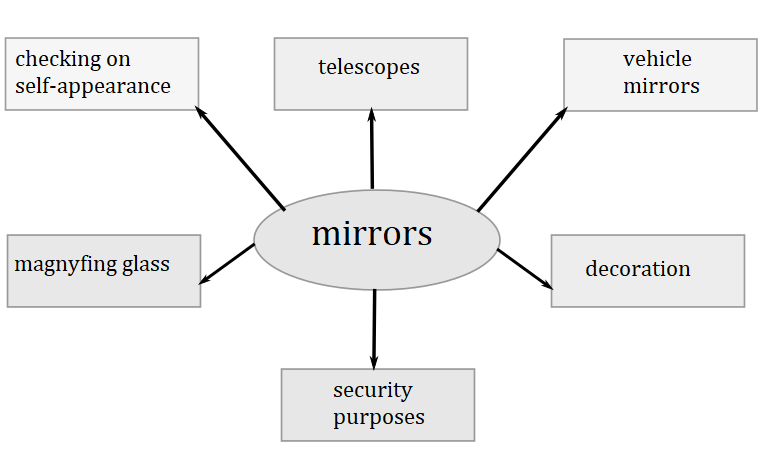
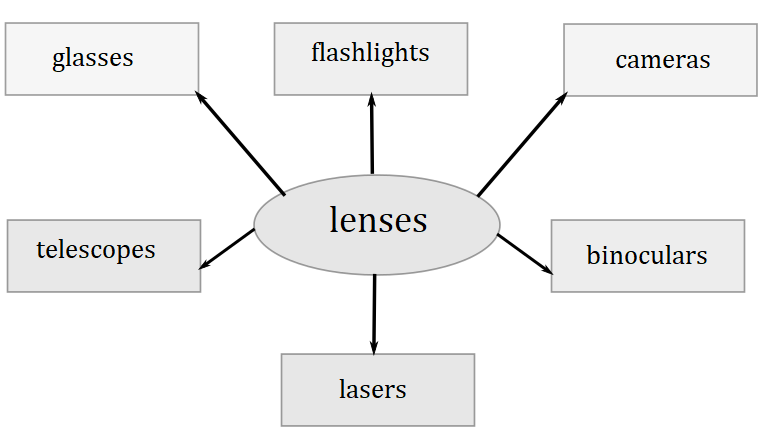
James Gregory has only made design for reflective telescope which later, Newton has constructed.
This telescope, which was made by Sir Isaac Newton uses concave mirror as the primary one and flat, diagonal mirror as the secondary one.
This telescope uses concave mirror as a primary mirror and convex mirror as the secondary one.
begin{tabular}{|l|l|l|l|l|l|}
hline
multicolumn{6}{|l|}{Laser} \ hline
multicolumn{2}{|l|}{begin{tabular}[c]{@{}l@{}}why are they\ used in medicineend{tabular}} & begin{tabular}[c]{@{}l@{}}ablating tissue\ by vaporisation of \ the tissue surfaceend{tabular} & begin{tabular}[c]{@{}l@{}}internal surgery \ without open woundend{tabular} & begin{tabular}[c]{@{}l@{}}producing a \ precise wound \ while cutting deeplyend{tabular} & begin{tabular}[c]{@{}l@{}}reducing blood \ lossend{tabular} \ hline
multicolumn{2}{|l|}{uses in medicine} & general surgeries & burning tissue & dental procedures & cosmetic procedures \ hline
end{tabular}
Lasers are being used for treating scars, wrinkles, damages on the skin which are caused by sun etc.
Also it is used for tattoos removal, lifting etc.
This burning procedure with laser during which layers of skin are being vaporised, removes wrinkles, scars, stains etc., but cosmetician which is performing this type of surgery has to be very careful since this surgeries can cause permanent damage on the skin.
The telescope that he has been using was a refracting telescope which had convex lens at the objective and concave eyepiece at the end of the long tube.
Also he has been observing Venus and Moon, and he discovered phases of Venus and valleys and hills on the Moon.
The MOST team was created in 1996., with the main goal to search the age of the universe and to find and search for extrasolar planets.
The telescope was also designed to be light-weighted with weighing only 54 kilograms and was constructed with a highly precise telescope that measures 15 centimeters in diameter.
Their purpose was to research stars while orbiting around the earth and did make success upon it became operational. It discovered that Procyon didn’t have any pulsations at all, and with that founding contradicted opinion older than 20 years, and made the astronomers rethink their model for stars.
Compound microscope is microscope which is using combination of lenses to enlarge image of the sample which is being observed.
He was the first to notice bacteria, blood cells etc.
Ernst Leitz found a way with which the magnifications of multiple lenses could be changed.
Ernst Abbe and Zeiss have developed UV microscope.
Difference between compound and electron microscope is that in the case of compound one source of illumination is visible light and in the case of electron one is current, also in electron microscope are used electromagnetic lenses and in the case of compound one glass lenses are used.
Optics has made positive contributions to society.
Mirrors are not just for decoration or checking self-appearance, now they play main role in the construction of many useful devices, such as telescopes, for safety etc.
Lenses are used for eyeglasses without which we will not be able to fix our sight, also for microscopes and telescopes etc.
Optics has helped in developing transfer of information by signals which are travelling through the optic fibres, illumination has been improved by the invention of different kind of bulbs, lasers helped people in many different fields of work etc.
Usage of lasers in medical purposes is interesting application of light.
Laser is beam of light which travels in straight line, rays have same speed and wavelength, therefore their energy is being focused, which gives it a high energy.
That is why lasers can easily and precisely cut through the skin or flesh during surgeries.
Also, laser light is used in cosmetic purposes such as removing scars or tattoos, even wrinkles.
This application is beneficial to the society since our life may depend on those surgeries and laser can help during them.

